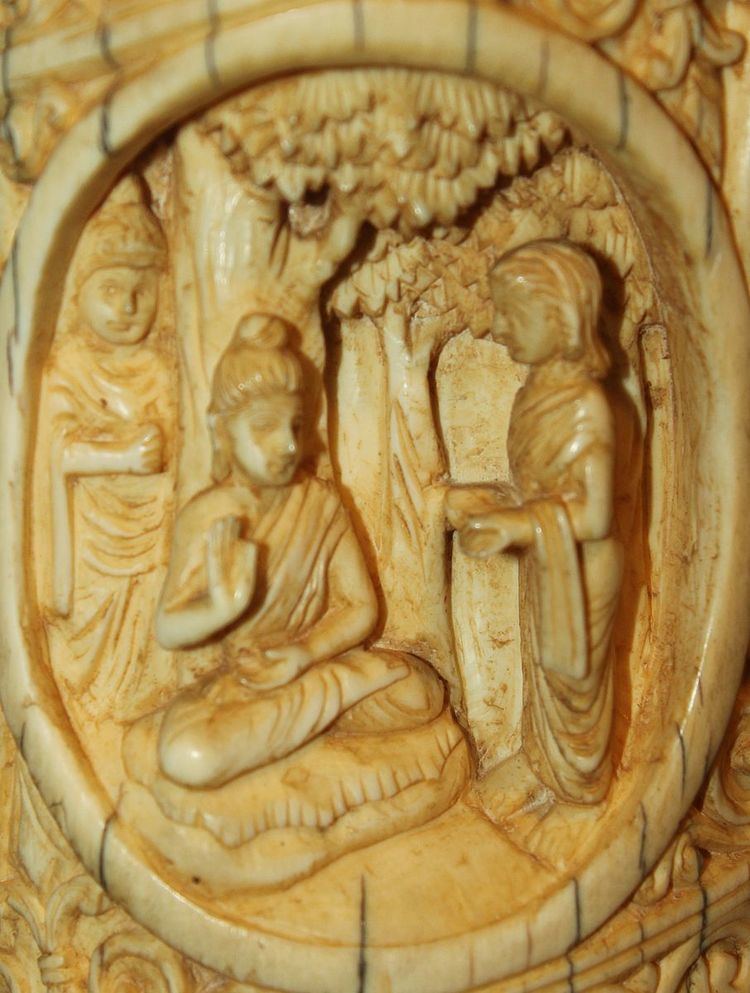Teacher Gautama Buddha Name Nanda Nanda | Role Gautama Buddha's sister | |
 | ||
Princess Sundari Nanda was the half-sister of Siddhartha Gautama, who later became Gautama Buddha. She became a nun after the enlightenment of her half-brother and became the foremost bhikkhuni in the practise of jhana (total meditative absorption). She lived during the 6th century BCE in what is now Bihar and Uttar Pradesh in India.
Contents
Early years
When she was born, Nanda was lovingly welcomed by her parents: Her father was King Suddhodarna, also the father of Siddhartha; her mother was Mahaprajapati. Mahaprajapati was the second wife of Suddhodarna and the younger sister of his first wife, the late Queen Maya. Nanda's name means joy, contentment, pleasure, and was named as her parents were especially joyous about the arrival of a newborn baby. Nanda was known in her childhood for being extremely well-bred, graceful and beautiful. To disambiguate her from Sakyans by the same name, she was also known as "Rupa-Nanda," "one of delightful form," or sometimes "Sundari-Nanda," "beautiful Nanda." Over time, many members of her family, the family of the Sakyans of Kapilavastu, left the worldy life for the ascetic life, inspired by the enlightenment of their Crown Prince Siddhartha. Amongst them was her brother Nanda, and her cousins Anuruddha and Ananda, who were two of the Buddha’s five leading disciples. Her mother, was the first Buddhist nun, having asked the Buddha to allow women into the sangha. As a result of this, many other royal Sakyan ladies, including Princess Yasodharā, the wife of Siddhartha became Buddhist monastics. Thereupon, Nanda also renounced the world, but it was recorded that she did not do it out of confidence in the Buddha and the dharma, but out of blood love for her relatives and a feeling of belonging.
Renunciation
It soon became obvious that Nanda was not fully focused on her life as a nun. Nanda's thoughts were mainly directed centred on her own beauty and her popularity with the people, characteristics which were the karma of meritorious actions in past lives. These karmic traits became impediments to Nanda, since she neglected to reinforce them with new actions. She felt guilty that she was not fulfilling the lofty expectations that others had of her, and that she was far from the objective for which so many of the Sakyan royal family had renounced their worldly life. She was certain that the Buddha would censure her, so she evaded him for a long time.
Enlightenment
One day, the Buddha requested all the bhikkhunis to come to him individually, to receive his teaching, but Nanda did not obey. The Buddha let her be called explicitly, and then she presented herself, in an ashamed and anxious demeanour. The Buddha addressed her and appealed to all of her positive qualities so that Nanda willingly listened to him and delighted in his words. He knew that the conversation had raised her spirits and had made her joyful and ready to accept his teaching. Since Nanda was so preoccupied with her physical beauty, the Buddha used his psychic powers to conjure the vision of a woman more beautiful than Nanda, who then aged quickly and visibly in front of her own eyes. As a result, Nanda could see, in a short time span, what could otherwise only be noticed in humans in a time span of decades: the recession of youth and beauty, the decay, the appearance of aging, such as wrinkles and gray hair. This vision affected Nanda deeply; she was shaken to the core. After having shown Nanda this confronting image, the Buddha could explain the law of impermanence to her in such a manner that she grasped its truth completely, and thereby attained the knowledge of future liberation — stream-entry. As a meditation subject, the Buddha advised her to contemplate the impermanence and foulness of the body. She persevered for extended periods with this practice "faithful and courageous day and night"; She described this in her verses:
Sick, impure and foul as well,
Nanda, see this congeries
With the unlovely, develop mind
Well-composed to singleness.
As is that, thus will this likewise be.
Exhaling foulness, evil smells,
A thing it is enjoyed by fools.
Diligently considering it,
By day and night thus seeing it,
With my own wisdom having seen,
I turned away, dispassionate.
With my diligence, carefully
I examined the body
And saw this as it really is —
Both within and without.
Unlusting and dispassionate
Within this body then was I:
By diligence from fetters freed,
Peaceful was I and quite cool.
As Nanda had been overly concerned with her physical appearance, it had been necessary for her to apply the extreme of meditations on bodily unattractiveness as a counterbalance to find equanimity between the two opposites.
Later the Buddha recognised his half-sister as being the foremost amongst bhikkunis who practiced Jhana. This meant that she not only followed the analytical way of insight, but emphasised the experience of tranquillity. Enjoying this pure well-being, she no longer needed any sensual enjoyments and soon found inner peace, despite having become a member of the sangha out of attachment to her relatives.
